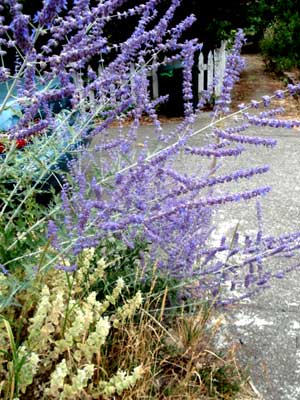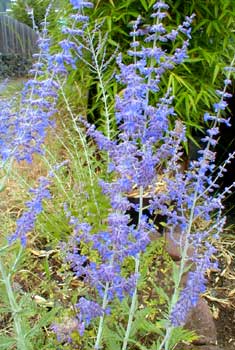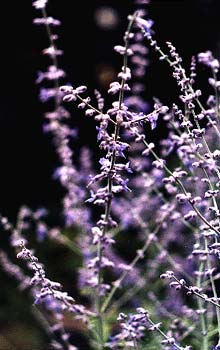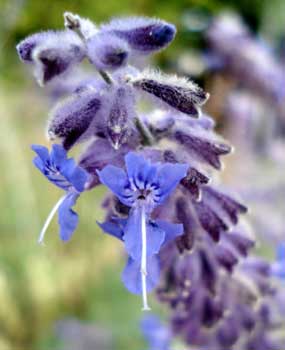
Russian Sage
"Here, some pinks & laurel leaves,
& a handful of sage."
-Walt Whitman
(1819-1892)
(1819-1892)
 The usual variety of Russian Sage offered in nurseries is called 'Blue Spires' & is a Hybrid of Perovskia atriplicifolia and P. abrotanoides, though sold as P. atriplicifolia. Plus there is a recent smaller version called 'Little Spire,' likewise hybridized.
The usual variety of Russian Sage offered in nurseries is called 'Blue Spires' & is a Hybrid of Perovskia atriplicifolia and P. abrotanoides, though sold as P. atriplicifolia. Plus there is a recent smaller version called 'Little Spire,' likewise hybridized. But the clumps shown here (photographed on the alley-side August 2009, August August 2004. & July 2003) were not labeled 'Blue Spires' or any other cultivar name, so presumedly are the species, though I'm uncertain. The primary difference is the wild form gets taller & perhaps lankier than the hybrid Russian Sage cultivars, & these are certainly huge & rather tippy.
The species grows to five feet typically, but not impossibly over six feet. The many tiny flowers on slender spikes look like smoky-blue branches from no later than July & continue very strongly up to first frost, which in our area can be November.
Foliage additionally gains somewhat attractive fall colors of gold & yellow, then has whitish grey twigs in winter which can also look thrilling. If the twigs eventually get tatty or messy looking, they can be sheared back to under two feet at any time.
 The woody stemmed bush has two kinds of silver-green leaves, the lower leaves deeply & finely cut, the upper leaves simpler & serated.
The woody stemmed bush has two kinds of silver-green leaves, the lower leaves deeply & finely cut, the upper leaves simpler & serated. To call it low-maintenance is an understatement. It wants full bright sun & not much water, even normal rainfall may be too much for it, so it is good to put it on a dry ledge or mound to insure maximum drainage.
We have it at the very corner edge of the property where irrigation doesn't reach, & it never suffers even in record-breaking days of drought. Most xeric garden plants really do need occasional watering, but this one, after its first year when it needs some attention to establish a good root system, it can forever be ignored.
The leaves have a marvelous sage-minty odor especially when brushed against. So the fact that it flops on the sidewalk a bit is sort of a good thing as we can bump into it to fine effect for our noses.
 Long-lasting as cut flowers, they can bring quite a pleasing scent into the home. They also hold their scent as dried flowers.
Long-lasting as cut flowers, they can bring quite a pleasing scent into the home. They also hold their scent as dried flowers. Hardy at minus 20 to minus 10 degrees, at the colder end of its tolerances it will die to the ground & return in spring, but is otherwise a deciduous subshrub, dormant in winter when the grey twigs can still hold interest.
If it experiences too much shade or too rich a soil, it may need staking, but in full sun is quite woody & strives to stand upright without assistance, though new enormous flower stems will lean over at the edges of the clump, or lean into sunlight if not sunned both morning & afternoon.
In spring before new growth begins, it is ideally cut back to a foot & a half or two feet height to assist attractive new growth, but at the very least any branches damaged or dead through winter should be trimmed off.
Though it can be divided autumn or spring, it generally remains a fairly tight clump, spreading so slowly that divisision is a slow method of propogation. It can easily be started from four-inch stem cuttings.
Russian Sage is native of Afghanistan & western Pakistan rather than Russia, but the genus is named for a Russian general. In 1995 it was selected as Perennial of the Year by the leading association of perennial growers.